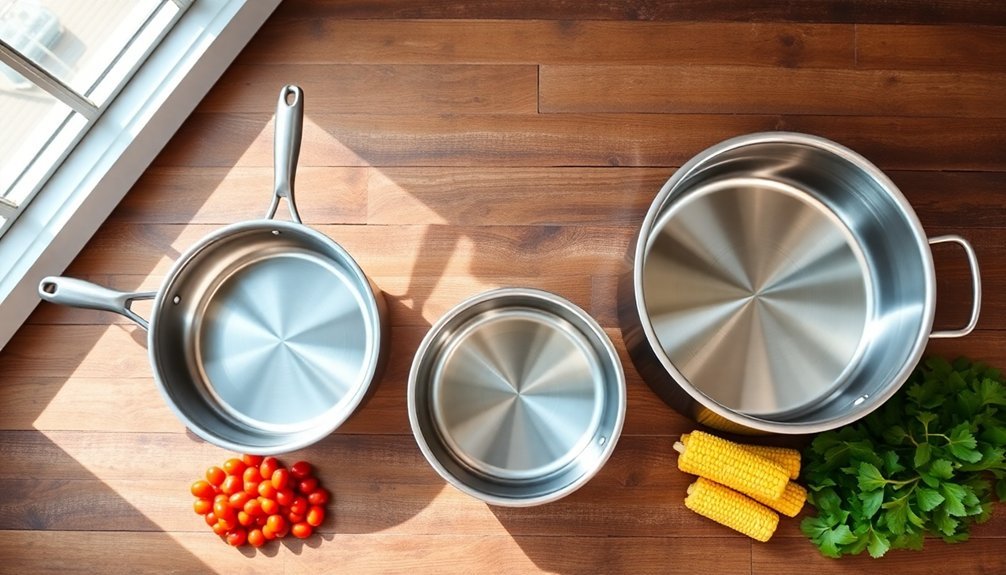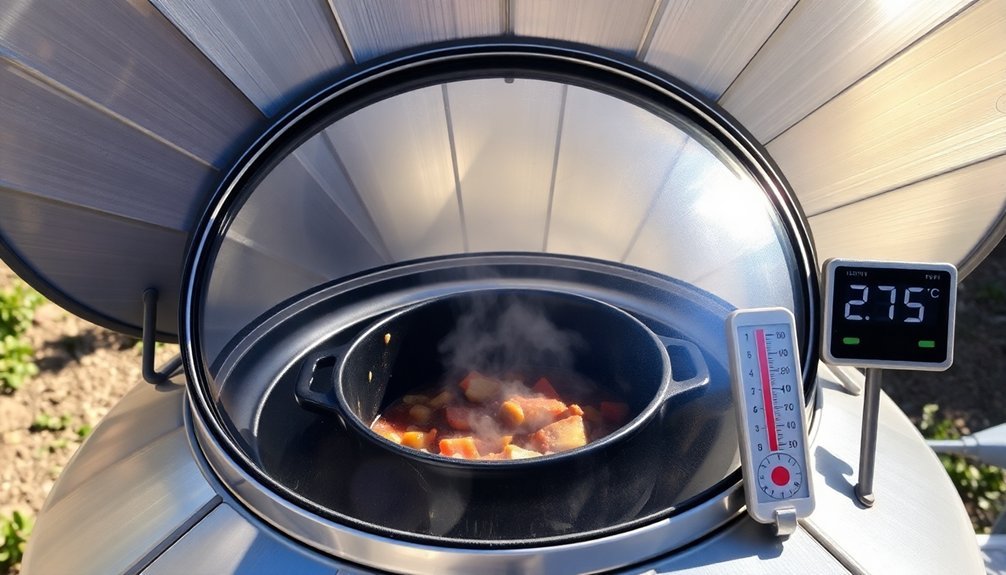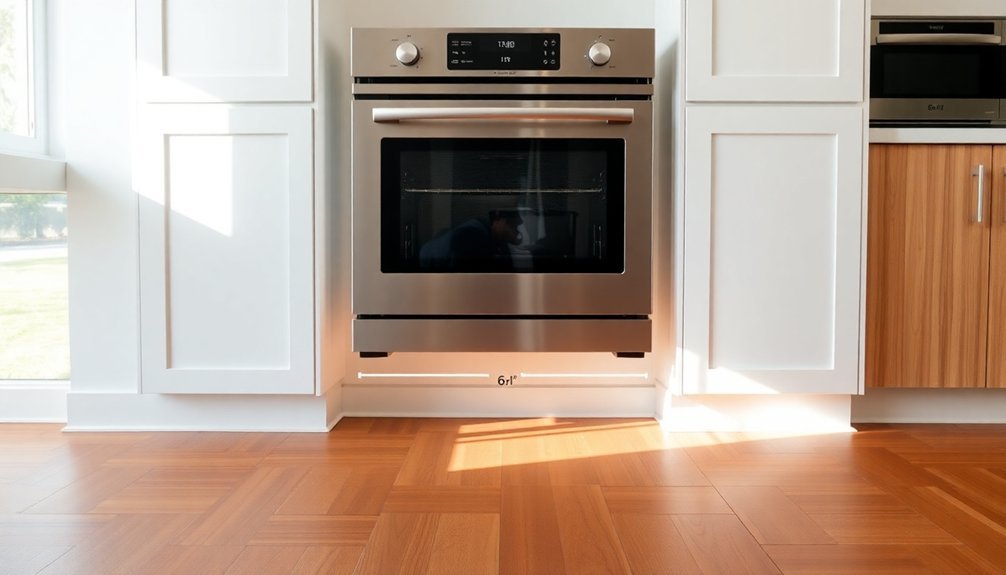When choosing your cookware, focus on matching pot sizes to your typical meal portions to avoid waste and guarantee even cooking. You'll want shallow, wide pots for better heat distribution, while selecting dark-colored cookware helps maintain consistent temperatures. Consider stacking compatible pots to maximize your cooking space, and don't forget to account for food expansion when selecting sizes. For best results, pick conductive materials like copper or aluminum, and remember that thinner pans allow for quicker temperature adjustments. These fundamental size tips will elevate your cooking game, but there's much more to mastering the perfect pot selection.
Matching Solar Pot To Recipe

When choosing a solar pot for your recipe, matching the right size and shape is essential for cooking success. You'll want to select a shallow, wide pot rather than a tall, narrow one for ideal heat distribution.
Estimate your recipe's total ingredient volume first, then pick a pot that accommodates that amount without overcrowding. For the best results, use a thin, black pot that heats quickly, especially in temperate climates. Learning to manage capacity like with stock pots' volume is crucial, which typically ranges from 6-20 quarts.
Avoid thick materials like cast iron that take too long to warm up. Place your pot on an open-mesh wire stand about 6 centimeters high to capture reflected sunlight from underneath.
If you're making stocks or boiling water, you'll need a larger pot, while smaller portions work better in compact vessels. Remember that deeper pots help control evaporation during long simmering times.
Essential Solar Cooking Capacity Guide
Although solar cooking offers great flexibility in pot choices, understanding capacity requirements will help you cook more efficiently. You'll find that dark-colored pots with tight-fitting lids are your best option, whether you're using a standard round pot or a larger roaster. The depth of cookware has minimal impact on cooking performance.
| Pot Type | Cooking Capacity |
|---|---|
| Round Pot | 1 whole chicken |
| Mid-size Roaster | 2 whole chickens |
| 5 Qt Casserole | Large family meals |
For maximum efficiency, you can double-stack standard pots on the leveling tray. Most foods will cook within 3-4 hours in moderate temperatures. If you're using a light-colored pot, simply cover it with a dark cloth to improve heat absorption. Remember that heavier pots maintain more consistent temperatures during cloudy periods, making them ideal for longer cooking sessions.
Proper Heat Distribution Methods

Understanding proper heat distribution starts with selecting the right materials and pan thickness for your cooking needs.
You'll want to look for cookware that combines conductive materials like copper or aluminum with non-reactive materials, such as in multiclad stainless steel construction.
For searing and high-heat cooking, choose thicker pans that retain heat well. If you're doing quick-cooking methods or need faster temperature adjustments, opt for thinner pans.
For optimal performance on induction burners, high-end cookware like Demeyere Atlantis and Proline show minimal temperature loss compared to other options.
You can test your pan's heat distribution by monitoring temperatures at different points across the surface using a thermometer.
To maintain ideal heat distribution, keep your cookware clean and properly seasoned, especially for cast iron pieces.
Don't forget to take into account the size of your cooking surface – larger pots need excellent heat distribution for consistent results across their entire surface.
Size Adjustments For Sun Cooking
Selecting the right pot size for solar cooking can dramatically affect your cooking success.
You'll find smaller pots heat faster and cook more evenly, making them ideal for vegetables and quick-cooking items. If you're cooking larger portions, like whole chickens or stews, opt for bigger pots but expect longer cooking times.
When adjusting your pot sizes for solar cooking, you're not limited by shape or depth. Both deep bean pots and shallow casserole dishes work well.
Choose black enameled pots, dark-interior Pyrex, or black-painted aluminum cookware for best heat absorption. You'll want to use lids to retain heat and consider dividing food into smaller portions for more uniform cooking.
Remember to position your solar cooker facing the sun and refocus it periodically for consistent temperatures.
Dark Cookware Selection Tips

When choosing dark cookware for your kitchen, you'll find these pieces offer distinct advantages for specific cooking methods. Dark pans, especially cast iron, distribute heat evenly and maintain temperatures longer, making them perfect for searing meats and roasting vegetables.
You'll need to adjust your cooking approach with dark cookware. Lower your oven temperature by 25 degrees and check food earlier than recipes suggest to prevent over-browning.
While these pans excel at creating crispy crusts on pizzas and cornbread, they'll require regular maintenance, including proper seasoning and careful cleaning to prevent rust.
For baked goods that brown too quickly, consider using a silicone mat or wrapping the pan's exterior with foil.
Frequently Asked Questions
Can I Stack Two Different-Sized Stock Pots for Double-Boiler Cooking?
You shouldn't stack stock pots for double-boiler cooking. It's unsafe and unstable due to their design. Instead, use a proper double boiler or specialized insert that's designed for this cooking method.
How Do Extreme Altitude Changes Affect Stock Pot Cooking Times?
You'll need to increase cooking times up to 25% at high altitudes since water boils at lower temperatures. Cover your stock pot to retain moisture and expect a 20-minute recipe to take 23 minutes at 5,000 feet.
What's the Best Pot Size for Making Homemade Soap Batches?
You'll need a 6.2 cup Rubbermaid bowl for small 4-pound batches, or an 8-quart stainless steel stockpot for larger amounts. For industrial batches, use a five-gallon bucket that holds up to 40 pounds.
Should I Adjust Pot Size When Cooking With Induction Versus Gas Stovetops?
Yes, you'll need to be more selective with pot sizes on induction cooktops. Use pans at least 4.75" for 6-inch burners, while gas stoves don't have size restrictions and work with any cookware.
Can Stock Pots Be Safely Used for Overnight Slow Cooking?
You can safely use stock pots for overnight cooking if you maintain proper temperature control, guarantee adequate liquid levels, and use a heavy-bottomed pot. However, a dedicated slow cooker's better for overnight cooking.
In Summary
You'll find solar cooking success comes down to proper pot selection. Remember to match your cookware size to both your recipe portions and the solar cooker's capacity. Don't forget that dark-colored pots absorb heat better, while proper sizing guarantees even heat distribution. When you're choosing pots, stick to these sizing guidelines and you'll achieve consistent results in your solar cooking adventures.





Leave a Reply